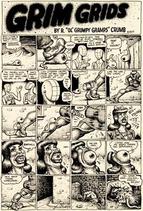Robert (R Crumb) Crumb
 Acclaimed by many as a pioneer, Robert Crumb’s Zap Comix (1968) is regarded as the first, but not the earliest, underground comic book. Crumb was the first cartoonist of the movement to achieve mainstream publication.
Acclaimed by many as a pioneer, Robert Crumb’s Zap Comix (1968) is regarded as the first, but not the earliest, underground comic book. Crumb was the first cartoonist of the movement to achieve mainstream publication.
Crumb was born in Philadelphia. Although he never studied art, his first job was drawing the “Hi-Brow” line of humorous greeting cards for the American Greetings Corporation. During his six years with that Cleveland firm, he began contributing to such underground newspapers as Yarrowstalks in Philadelphia, the East Village Other in New York, and to Harvey Kurtzman’s innovative humor magazine Help!, which published several of his pieces. Never a member of the counterculture himself, Crumb created a large and diverse body of work during the late 1960s and early 1970s. To a large extent he defined underground comics. He produced a number of solo books between 1968 and 1971, including Zap, Big Ass, Despair, Uneeda, Mr. Natural, and many others.
His subjects, the preoccupations of the rebellious youth of the 1960s, were to become the staples of the genre: sex (Crumb’s treatments of it were so explicit that they led to a famous censorship trial), drugs, and the decay of spiritual values. His pen was merciless. He spared nothing and no one, including himself. Among his most enduring creations were the archetypal “straight” Whiteman; the dumb hippies yearning for spiritual enlightenment (but unwilling to give up their TV), Flakey Foont and Shuman the Human; and the sublimely cynical guru, Mr. Natural.
In drawings that spoofed all the cartoonists of the 1930s, Crumb managed to achieve an unmistakable style of his own, which became one of the most pervasive of his period. His collected works, expected to exceed 20 volumes, is now in preparation. It is a sure sign of his cultural institutionalization.
In the middle 1970s, this eccentric and very private figure dropped from sight almost completely. His Mr. Natural series in the Village Voice ended abruptly on November 29, 1976, with the artist appearing in person to say “So long, folks.”
Crumb thereafter allegedly retired to devote time to raising chickens in California. The 1980s, however, found him very much back in the field. He launched Weirdo, a determinedly underground black and white publication to which he was a regular contributor, as was his wife Aline Kominsky, who also edits.
The year 1987 saw the advent of Hup, an infrequent black and white written and drawn entirely by Crumb. (An introductory page claimed that the magazine “wants you to achieve REAL EMOTIONAL MATURITY!”) Many of Crumb’s best-known characters show up in Hup, including Mr. Natural and Crumb himself.
Since the early 1990s, Crumb and his wife, Aline Kominsky-Crumb, have lived in France.
Sources:
Ron Goulart, Editor, The Encyclopedia of American Comics
Wikipedia, Aline Kominsky Crumb